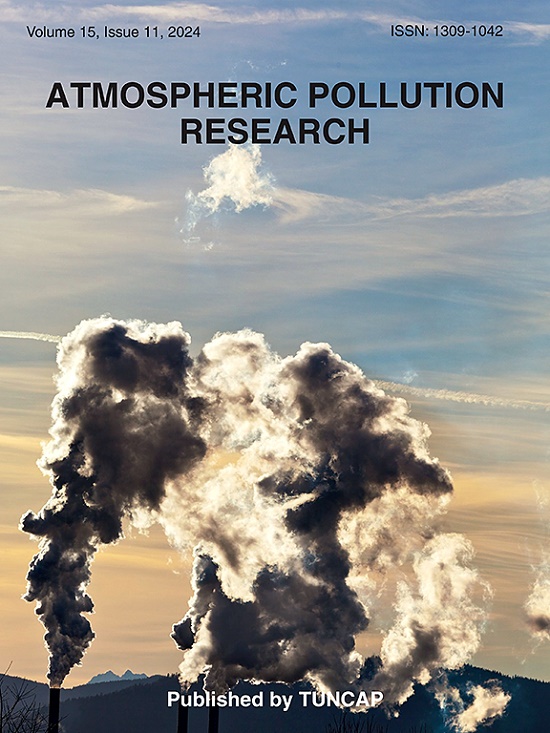Observations of surface CO2 at an urban station in Wuhan, Central China: temporal variations, sources, and sinks
IF 3.5
3区 环境科学与生态学
Q2 ENVIRONMENTAL SCIENCES
引用次数: 0
Abstract
Observation of atmospheric carbon dioxide (CO2) is important to understand its temporal variations, sources, and sinks, which ultimately help mitigate its climate effects. While most CO2 observations are conducted in background or remote regions, fewer studies focus on urban areas. This study reported a one-year continuous observation of CO2 at an urban site in Wuhan, Central China. In 2023, the average CO2 concentration at this site was 459 ± 23.5 ppm, which was 5.53 % higher than mean values collected from other urban stations. Using the moving average filtering method, the CO2 concentrations were filtered as a pollution source, background, and absorption sink with mean concentrations of 494 ± 21.1 ppm, 455 ± 16.1 ppm, and 434 ± 9.61 ppm, respectively. Temporal variations of these components showed similar monthly trends but different diurnal patterns, reflecting the influences of terrestrial ecosystems and human activities. Model simulations from Carbon Tracker indicated that fossil fuel combustion was the primary source, increasing CO2 levels by 125 ppm. The ocean and biosphere acted as CO2 sinks, reducing concentrations by 31.6 ppm and 31.2 ppm, respectively. The conditional bivariate probability function results suggested that urban CO2 levels were influenced by local emissions and regional transports. Combined with backward trajectory analysis and CO2 emission inventory, the local and regional contributions were further quantified with percentages of 81.9 % and 18.1 %, respectively. This study enhances our understanding of greenhouse gas behaviors and contributes to efforts to achieve carbon neutrality in urban areas.
武汉城市站地表CO2观测:时间变化、源和汇
对大气二氧化碳(CO2)的观测对于了解其时间变化、来源和汇非常重要,最终有助于减轻其气候影响。虽然大多数二氧化碳观测是在背景或偏远地区进行的,但很少有研究关注城市地区。本研究报告了在中国中部武汉一个城市站点进行的为期一年的CO2连续观测。2023年,该站点的CO2平均浓度为459±23.5 ppm,比其他城市站点的平均值高5.53%。采用移动平均过滤法,将CO2浓度作为污染源、背景和吸收汇进行过滤,平均浓度分别为494±21.1 ppm、455±16.1 ppm和434±9.61 ppm。这些分量的月变化趋势相似,但日变化模式不同,反映了陆地生态系统和人类活动的影响。Carbon Tracker的模型模拟表明,化石燃料燃烧是主要来源,使二氧化碳水平增加了125 ppm。海洋和生物圈起到了二氧化碳汇的作用,分别降低了31.6 ppm和31.2 ppm的浓度。条件二元概率函数结果表明,城市CO2水平受当地排放和区域运输的影响。结合反向轨迹分析和CO2排放清查,进一步量化了本地和区域贡献的百分比,分别为81.9%和18.1%。本研究增强了我们对温室气体行为的理解,有助于实现城市地区的碳中和。
本文章由计算机程序翻译,如有差异,请以英文原文为准。
求助全文
约1分钟内获得全文
求助全文
来源期刊

Atmospheric Pollution Research
ENVIRONMENTAL SCIENCES-
CiteScore
8.30
自引率
6.70%
发文量
256
审稿时长
36 days
期刊介绍:
Atmospheric Pollution Research (APR) is an international journal designed for the publication of articles on air pollution. Papers should present novel experimental results, theory and modeling of air pollution on local, regional, or global scales. Areas covered are research on inorganic, organic, and persistent organic air pollutants, air quality monitoring, air quality management, atmospheric dispersion and transport, air-surface (soil, water, and vegetation) exchange of pollutants, dry and wet deposition, indoor air quality, exposure assessment, health effects, satellite measurements, natural emissions, atmospheric chemistry, greenhouse gases, and effects on climate change.
 求助内容:
求助内容: 应助结果提醒方式:
应助结果提醒方式:


